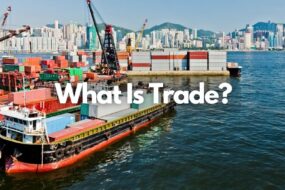

- Home
- Market Trends
- How to Find Buyers For Your Ex ...
In the export business, it doesn’t matter if you are a newcomer testing international waters for the first time or an established exporter looking to grow your business abroad. Your main challenge is always to find buyers for the goods or services you provide. Selling in an unknown country is never easy. There are physical distances, cultural differences and language barriers to consider, among other things. Luckily, we live in a time where technological advances have shrunk our world and brought us closer. This means it’s easier to find foreign buyers for your export business today than it was, say, 20 years ago.
1. Finding a market
- How to identify foreign markets for your export product with the help of product analysis and market research
2. Finding buyers
- Offline and online ways to find and connect with foreign buyers
Finding a market for your export business
1. Where is the demand?
2. Is it a stable market?
- Does the importing country produce what I export?
- If not, could they start producing it any time soon?
- Is demand there subject to seasonal trends?
- Has demand been consistent or grown in recent years?
- Can the importing country get the same product from a rival supplying country more easily?
3. Is it profitable?
- The price a foreign buyer is willing to pay for your product
- Additional costs that can increase the price of your export product, such as freight, clearing and forwarding, terminal handling, loading and unloading, packaging, marking and labelling, insurance, guarantee/warranty, and marketing
- Factors that can reduce the price of your export product, such as customs and excise duty refunds, export assistance schemes, export credit facilities
- The price offered by a rival supplier for the same product
4. Are there trade barriers?
5. Is the climate business-friendly?
Finding buyers for your export business
Online methods
- Website/blog: The first step is to set up a website for your business. Make it attractive and professional as first impressions matter. Including regularly updated information about your products and manufacturing processes, with photographs, can give your business credibility. Using search engine optimisation (SEO) will ensure your website pops up on Google whenever a relevant search request is made by potential buyers in your target country. Search Engine Marketing and Google Search Console are other tools at your disposal to increase your website’s visibility. Apart from a website, you can start a blog to inform potential buyers about your products.
- Social media: Social media can be a valuable resource in your search for foreign buyers. You can reach a global audience by having a presence on Facebook, Twitter, Instagram, YouTube, LinkedIn, and Reddit. You could, for example, join a Facebook group that connects buyers and sellers and provides trade tips. There are benefits to having a social media marketing strategy for your export business; it is not difficult to develop a well-thought-out strategy and, best of all, it is not expensive.
- Email marketing: Email marketing is another internet marketing strategy that you can employ. This is when you send newsletters, sales promotions, and exclusive deals and offers to potential buyers via email. An email is surprisingly effective. It is more likely to be seen than a social media post. You can create your own email list or purchase a database of importers and retailers. Just remember to follow all applicable laws when sending business emails. Spamming is not acceptable.
- B2B websites: Registering with business-to-business (B2B) websites like Alibaba, Global Sources, DHgate, Made in China, Tradewheel, and iOffer is another effective way to reach a large customer base. Millions of buyers and sellers use these platforms. Alibaba, for example, is the world’s third-largest retailer, trailing only Walmart and Amazon. There are also numerous Indian B2B companies that connect exporters and buyers, such as IndiaMART, TradeIndia, and Exporters India.
- Trade Data Pro: As its name suggests, Trade Data Pro collects and consolidates cross-border import and export trade data from over 100 countries around the world. You can use the buyer and supplier lists to identify potential buyers and track existing customers based on customisable search criteria. View the trading history of your counterpay to help you review and assess their reliability based on frequency and amount of transactions. Use Trade Data Pro trade data and relationship mapping to help you optimise business decisions based on the supply chain relationships of existing and emerging market competitors.
Offline methods
- Trade fairs and expos: You can attend a trade show in your target country. Many countries host several trade fairs each year, attracting hundreds of thousands of buyers and sellers. If you’re considering exporting to China, for example, you could attend the Canton Fair, the country’s largest trade fair, which is held twice a year. If flying to another country is too difficult, India hosts numerous trade fairs and expos that attract international buyers. These events are covered in detail on the websites of the Federation of Indian Export Organizations (FIEO) and the Export Promotion Council. At a trade show, you can show prospective buyers product samples, answer their questions, and even close deals. Trade shows are advantageous because you can interact with buyers in person. These events are covered in detail on the websites of the Federation of Indian Export Organisations (FIEO) and the Export Promotion Council. You can show prospective buyers product samples, answer their questions, and even close deals at a trade show. Trade fairs are a great way to form long-term relationships because you deal with buyers in person.
- Export promotion bodies: Several government agencies in India have been established to promote the country’s exports. The 14 Export Promotion Councils and five Commodity Boards are part of the Ministry of Commerce and Industry. Exporters can use their assistance in finding foreign buyers. These organisations provide information and organise delegation visits to various countries so that you can explore market opportunities or attend trade fairs.
- Chambers of commerce: Chambers of commerce, also known as trade associations, are global networks of businesses and corporations. They can provide information on importers for your product in the country of your choice. Alternatively, you can join a chamber of commerce. This means that your company is listed on the chamber’s website, which will increase your visibility among buyers.
- Third-party agencies: There are several third-party agencies in your target country that can help you find buyers, generate sales for your product, and navigate language and cultural barriers. Third-party agencies include:
- Foreign agencies – State-sponsored trading firms that import goods in bulk for their country. There are various agencies for various products.
- Buying agents – Bulk buyers interested in importing from your country. Some of them work for international organisations. Foreign agencies and purchasing agents can be found at the embassy of the importing country in your country.
- Foreign wholesalers – Bulk buyers looking to import from your country. Some of them work for international organisations. Foreign agencies and purchasing agents can be found in your country’s embassy of the importing country.
- Commission agents – For a fee, foreign agents connect foreign wholesalers with goods suppliers in other countries.
- Your own salesperson: Your own sales agent or salesperson in your target country who assists you in finding buyers and finalising orders for a commission. A good sales agent also conducts market research, leads negotiations, provides after-sales services, and manages your accounts.
- Market research companies: When entering a new market, knowledge is essential. Market research firms, as the name implies, focus on market research and studies. You can pay them for information specific to your product or industry, as well as importer directories in specific countries.
- Industry resources and personal contacts: Finally, you have personal contacts (friends, family) and business contacts (fellow businessmen, companies) who can assist you in contacting new international buyers.
Some useful tips
- Before you start looking for buyers, you should have a solid export business plan. Consider whether you have the capacity to meet the demands of a new market.
- When creating your website, ensure that it can be translated into the language of your intended audience.
- Select the appropriate social media platform. In some countries, there may be restrictions or an outright ban on a specific platform. China, for example, has restricted access to Facebook, Twitter, YouTube, and Instagram. If you want to continue using social media marketing in China, Weibo is the Chinese equivalent to Twitter.
- Be aware of the customs and cultures in your target country so that you do not offend your buyers.
- Understand your target country’s legal and regulatory requirements.
- Working with intermediaries/middlemen reduces your margins. However, if they bring you a lot of business, this shouldn’t be an issue.
- To persuade your buyer of your product, communicate clearly with them. Offering a sample or prototype will demonstrate to them that you mean business.
- Develop your reputation in order to retain and expand your customer base. One way to accomplish this is to provide prompt and efficient customer service.
How to ensure your buyer is genuine
- Verify that the buyer’s location and address are correct using Google.
- Examine their social media accounts (Facebook, Instagram, LinkedIn, etc). Their level of activity on these networks is usually an accurate reflection of how they conduct business.
- Examine the buyer’s website. Examine their “About Us” page, product listings, and any certificates, licences, or government agency memberships they may have displayed. Don’t forget to look at the domain age, which shows how long the website has been online.
- Following these online checks, the next step is to request certain documents from your prospective buyer, including but not limited to their import-export licence and certificate of membership in a government trade body (Export Promotion Council, for example). Check the documents again with the information you found online.
- Aside from government agencies, reputable private companies conduct buyer verifications for a fee.
- Finally, the best way to verify your buyer is to use Trade Data Pro to check the import history of the buyer!
The most trustable and reliable source for Trade Data.
Trade Data Pro is proudly made in Singapore. Singapore has been one of the world’s most politically stable countries, with an open and trade-driven economy. Trade Data Pro is presented by CIC, a government-linked company in Singapore CIC is a Join Venture of Zall Smartcom, SGX and GeTS.) Since the launch of Trade Data Pro in 2018, Trade Data Pro has received overwhelmingly positive remarks from market. This is because Trade Data Pro has wide coverage, low cost, and fast response. There are many leading companies from different industries that have subscribed to Trade Data Pro . Trade Data Pro was awarded with Singapore Quality Class in 2020 and Stevie Award Gold in 2021. Businesses need information to reveal trends, identify market opportunities, track competitors buyers and suppliers, and better understand supply chain potential. Finding these critical data has traditionally been challenging. But this information do exist, but as part of government import and export filing requirement. The detailed shipment information which are within these filings constructions the core of the global trade. Trade Data Pro has gathered and packaged these information as business intelligence. Our solution helps companies understand the flow of goods across borders and features the world’s largest searchable trade database. We do the heavy lifting for you by reviewing, standardising, and cleaning data, then delivering in an intuitive format.Social media can be a valuable resource in your search for foreign buyers. You can reach a global audience by having a presence on Facebook, Twitter, Instagram, YouTube, LinkedIn, and Reddit. You could, for example, join a Facebook group that connects buyers and sellers and provides trade tips. There are benefits to having a social media marketing strategy for your export business; it is not difficult to develop a well-thought-out strategy and, best of all, it is not expensive.
Archives
- April 2024
- March 2024
- January 2024
- December 2023
- November 2023
- October 2023
- September 2023
- August 2023
- July 2023
- June 2023
- May 2023
- April 2023
- March 2023
- February 2023
- January 2023
- December 2022
- November 2022
- October 2022
- September 2022
- August 2022
- July 2022
- June 2022
- May 2022
- April 2022
- March 2022
- February 2022
- January 2021
Categories
Recent Post
Chinese Automotive Expansion into Mexico for the
- April 29, 2024
- 6 min read
Global Economic Landscape: 2024 Outlook
- April 22, 2024
- 11 min read
China-Brazil Trade Relationship in 2024
- April 15, 2024
- 11 min read







